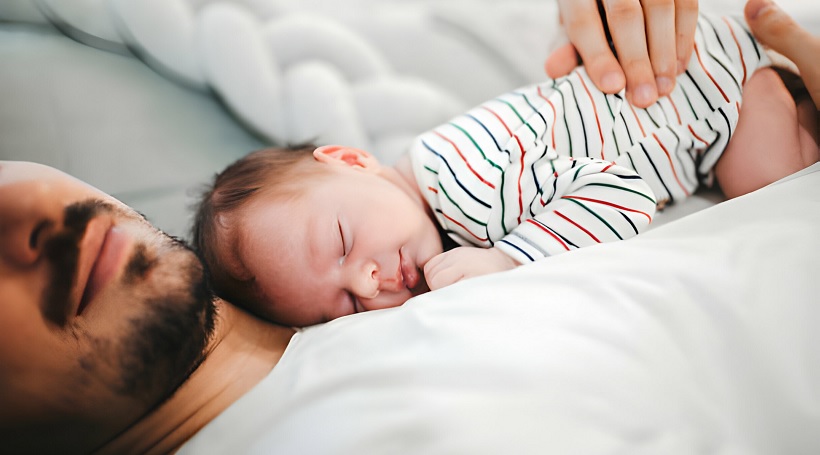Babies often sleep with their butts in the air because it’s a natural, instinctive position that mimics the fetal pose. This position, known as the “frog position,” is comfortable for babies, helps them maintain warmth, and can ease gas and abdominal discomfort, contributing to better sleep.
Sleep is a critical component of a baby’s growth and development, and the positions they assume during sleep can sometimes puzzle or amuse parents. One common and quite endearing posture is when a baby sleeps with their butt in the air, knees tucked under their abdomen, often resembling a little frog. This position, although peculiar at first glance, has roots in a baby’s innate behaviors and developmental needs. We write here about the reasons behind this sleeping pose, exploring its benefits and the instincts that drive babies to adopt it.

Read More – When Do Babies Grow Out Of Contact Naps?
The Comfort of Familiarity: Returning to the Womb
The “frog position” is a natural continuation of the fetal position that babies adopt in the womb. In this snug environment, space is limited, and babies naturally curl up with their legs and arms close to their bodies. After birth, this position continues to provide a sense of security and comfort, as it mimics the familiar, enclosed feeling of the womb. When babies sleep with their butts in the air, it’s a way for them to regain that sense of warmth and protection, making it easier for them to relax and fall into deeper sleep.
Developmental Benefits: More Than Just Comfort
Beyond comfort, the “frog position” has several developmental benefits. For infants, physical development is as crucial as cognitive growth. This sleeping posture promotes flexibility and strength in the hips and legs, preparing babies for the next stages of physical development, such as crawling and walking. The position also allows for easier movement during sleep, which is essential for muscle development and joint health.
Easing Digestive Discomfort
Many parents are familiar with the discomforts that can plague babies, such as gas and colic. The pressure applied to the abdomen when babies sleep in the “frog position” can help relieve gas and aid digestion. This natural self-soothing technique allows babies to alleviate discomfort without waking up, promoting longer and more restful sleep.
Read More – Transitioning From 3 Naps To 2: Signs Your Baby Is Ready
The Role of Instincts
The preference for sleeping with the butt in the air also has roots in basic human instincts. In the early stages of life, babies are driven by instinctual behaviors that ensure their survival and development. This position not only provides comfort and security but also ensures that babies can breathe freely. By keeping their face unobstructed and allowing for easy movement, babies can maintain clear airways throughout the night.
The Startle Reflex and Security
The “frog position” also caters to the startle reflex (Moro reflex), a primitive neurological response. This reflex can cause sudden jerks or the sensation of falling during sleep, leading to brief wake-ups. The enclosed, secure feeling of the “frog position” can reduce the impact of the startle reflex, helping babies feel secure and maintain uninterrupted sleep.
Observations from Pediatrics and Sleep Science
Pediatricians and sleep scientists affirm the benefits and natural aspects of this sleeping position. Research into infant sleep patterns suggests that babies naturally gravitate towards positions that offer the best comfort, security, and physiological advantages. The consensus is that as long as babies are put to sleep on their backs – in line with safe sleep guidelines – the position they shift into as they sleep is typically beneficial for their comfort and development.
Cultural Perspectives and Practices
Cultural practices around infant sleep vary globally, but the “frog position” is universally observed, transcending cultural boundaries. This universality underscores the innate nature of the position, driven by human biology and developmental needs rather than cultural conditioning.

Guidelines for Safe Sleep
While the “frog position” is natural and beneficial, parents must follow established guidelines for safe sleep to reduce the risk of Sudden Infant Death Syndrome (SIDS). The American Academy of Pediatrics recommends that infants be placed on their backs for sleep, in a crib free of loose bedding, bumpers, and toys. Once babies naturally roll into different positions on their own, it’s generally safe to let them be, as long as their sleep environment remains safe and secure.
Read More – When Do Babies Drop To 2 Naps?
FAQs
Why Babies Sleep With Their Butt In The Air?
Babies often sleep with their butts in the air because it replicates the fetal position, providing a sense of security and comfort. This “frog position” helps ease digestion, offers warmth, and can soothe abdominal discomfort, contributing to more restful sleep.
Why do babies sleep with their butts up?
Sleeping with their butts up allows babies to feel a comforting pressure on their stomach, which can relieve gas and aid digestion. This position, echoing the snugness of the womb, also promotes a sense of security that can enhance sleep quality.
Why is my toddler sleeping with her bum in the air?
Toddlers may sleep with their bum in the air for comfort and security, similar to younger babies. This position can also be a habit formed from infancy, providing a familiar and soothing sleeping posture that supports deep and restful sleep.
Why do babies have to sleep at the bottom?
Placing babies to sleep at the bottom of the crib, with their feet touching the end, prevents them from wriggling under the bedding, which could increase the risk of suffocation. This practice ensures a safer sleep environment, aligning with guidelines to reduce the risk of SIDS.
Why do babies lay with their legs in the air?
Babies lay with their legs in the air to explore their bodies and environment, enhancing their motor skills and body awareness. This position also helps relieve discomfort from gas, as lifting the legs can aid in passing gas and soothe abdominal pain.
Conclusion
The sight of a baby sleeping with its butt in the air, tucked into the “frog position,” is more than just a cute moment to capture. It’s a manifestation of instincts, developmental needs, and the innate wisdom of the human body. Understanding the reasons behind this common sleeping posture can provide reassurance to parents and caregivers, reminding them of the remarkable adaptability and resilience of infants. As we observe and support the natural tendencies of babies, we contribute to their healthy growth and development, ensuring a foundation for a thriving future.







